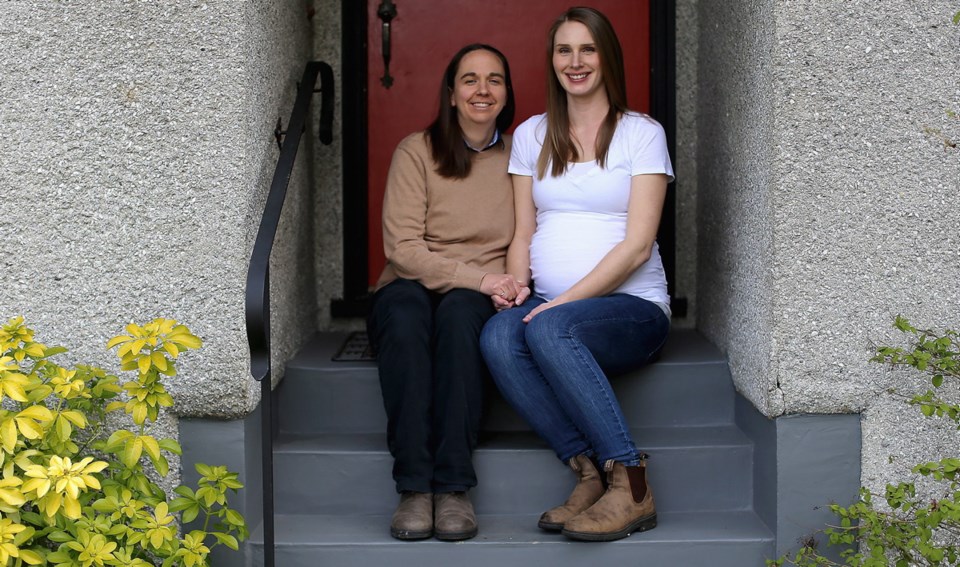Some pregnant women are changing their birth plans in response to new restrictions on the number of guests allowed in the delivery room and concerns around COVID-19.
New regulations from Island Health limit the number of guests that can accompany a woman in the delivery room to one per day.
For Kourtnee Hoitsema, who is 38 weeks pregnant with her first child, that means her doula, who provides emotional support and techniques for pain management, won’t be able to support her through her entire labour.
She’s decided to stay at home with her partner and doula as long as she can before going to the hospital.
“Now I feel like we’re kind of scrambling to make sure we know all the numbers and all the techniques,” she said. “[Our doula] will be available by phone, but it won’t be the same.”
Hoitsema was feeling so anxious about having to change her birth plan just a few weeks before her due date that she went on maternity leave several days early.
Hoitsema’s biggest concern was that the regulations would change and her partner wouldn’t be allowed in either, but she said she’s been reassured that won’t happen.
“I can’t imagine doing that without my partner,” she said.
Eva Bild, the owner of Mothering Touch, a perinatal resource centre and maternity store in Victoria, said she understands the desire to limit the number of people in the hospital, but the rule means women are receiving less support.
“If you’re pregnant and you have to choose between having your sweetheart there and having your doula there, you choose your sweetie,” she said. “So, it means that people are doing without their doulas.”
Some doulas are continuing to provide support by phone or video chats, said Bild, who is also a doula.
Prenatal classes have also shifted to virtual options. The Mothering Touch has replaced in-person classes with live-streamed classes so that soon-to-be parents can still engage with an instructor and ask questions.
Victoria doula Jessica Cherniak said she’s staying with her clients in labour as long as she can and bringing them right to the hospital door.
She’s also adapting her services to provide virtual care to some families before and after a birth, including help with a baby’s first bath by phone.
“We’re having to become very creative in how we support our clients,” she said.
She’s staying at home as much as possible except to visit clients to reduce the possibility of transmitting COVID-19 to new or expecting parents.
During a client’s recent labour, Cherniak noticed that the soon-to-be dad became really hands-on because he realized he was going to have to take over support during delivery without Cherniak there as planned.
“It was very empowering for him,” Cherniak said.
The COVID-19 crisis has also led some women to choose home births over the hospital.
Alix Bacon, president of the Midwives Association of British Columbia, said midwives are seeing an increased demand for home births.
“I would say families are looking to socially distance and minimize their contact with acute care facilities for infection prevention,” Bacon said.
The increase in demand to give birth at home has midwives concerned about access to personal protective equipment — gowns, masks and eye-protection — which is recommended by the sa���ʴ�ý Centre for Disease Control for anyone catching a baby, whether or not a birthing woman has symptoms. There have been widespread concerns that the equipment is in short supply for health care workers.
“I do appreciate that personal protective equipment is in high demand and health authorities are working to allocate masks and gloves and keep prioritized eye protection to the highest risk areas,” Bacon said. “Labour and delivery is a high-risk area due to the exposure to body fluid that occurs with birth.”
Midwives access home birth supplies through a provincial distribution centre that also provides equipment to ambulances and home care nurses, but the centre was not providing personal protective equipment to midwives up until Thursday night, Bacon said.
On Friday afternoon, a distribution chain was in the works to provide equipment to midwives on Vancouver Island, she said.
“It’s reassuring to know that midwifery leadership and the health authority are working together to address concerns,” Bacon said.
While some children and infants have tested positive for COVID-19, adults are the majority of reported cases, according to the U.S. Centers for Disease Control and Prevention. Infants and children are not considered to be at higher risk of severe symptoms.



